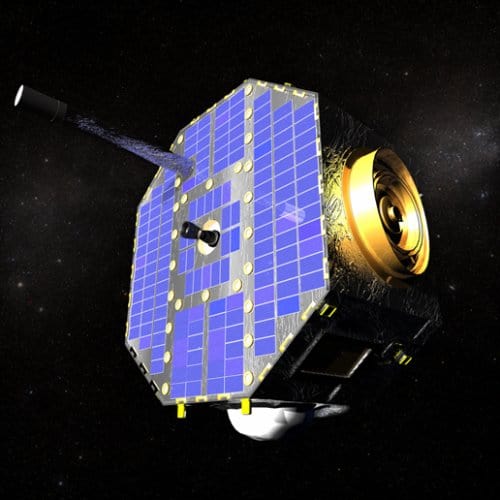
NASA’s IBEX satellite blasted off today to begin its mission to map the outer reaches of the solar system. The spacecraft was launched from an aircraft high above the South Pacific and will soon settle into a very high altitude Earth orbit, where it will study how ions in the solar wind interact with the plasma from interstellar space.
Scientists hope that IBEX will tell us more about the shape of the solar system’s protective “bubble”, which is created by the solar wind and shields us from harmful galactic cosmic rays.
The solar wind is a stream of charged particles emitted from the Sun in all directions and forms the protective region around the Sun known as the heliosphere. Without this bubble, radiation from outer space would make manned space flight extremely dangerous.
The solar wind collides with plasma in the interstellar medium some 10–20bn km from the Sun at the so-called termination shock. Beyond this, in a region known as the heliosheath, the solar wind slows down dramatically, becomes heated and turbulent. The heliosheath extends for several billion kilometres further from the Sun and its end marks the edge of the solar system.
A ‘global view’ of the heliosphere
Over the past four years the Voyager 1 and Voyager 2 spacecraft have both crossed the termination shock and sent back spectacular data on this region. However, as IBEX principal investigator David McComas explains, these data tell us only about the specific points at which the spacecraft crossed the termination shock. “It’s like having two excellent weather stations that provide detailed reports of the weather in their areas, but not having the satellite data that tell you how the weather fronts are changing,” he says. “For this global view we need IBEX.”
IBEX, being one of NASA’s small, low-cost Explorer missions, will be launched by a rocket released from the underside of an aircraft. The rocket will climb to about 200 km above the Earth’s surface, at which point an additional rocket will fire and send IBEX into a high-altitude orbit. Taking IBEX some 5/6 of the way to the Moon, this orbit will allow the satellite to spend much of its time outside of the Earth’s magnetosphere and therefore free from potential interference.
Once in position, IBEX will use two sensors to collect neutral hydrogen atoms that form when protons from the solar wind combine with electrons from interstellar neutral atoms drifting into the heliosphere, with some portion of these hydrogen atoms deflected back towards the Sun by their motion about the solar magnetic field lines. Because the satellite spins as it moves along its orbit, it will, over the course of six months, collect particles from every part of the sky. By measuring the direction from which the particles arrive, their time of arrival, their mass and their energy, McComas and colleagues will be able to build up a full-sky map showing the distribution of these particles and their energies.
How does the solar wind slow down?
Analysing this map will then allow the researchers to work out the interaction between the solar wind and the interstellar medium along the full length of the termination shock. For example, it will tell them whether the slowing down of the solar wind is fairly uniform in all directions or whether there are some places where it occurs abruptly and others where it takes place more slowly. It will also reveal the overall shape of the heliosphere, which might be affected by density fluctuations and field lines in the interstellar medium.
The mission has a nominal lifetime of two years but all of its components are designed to last for four and could last even longer, says McComas.




